
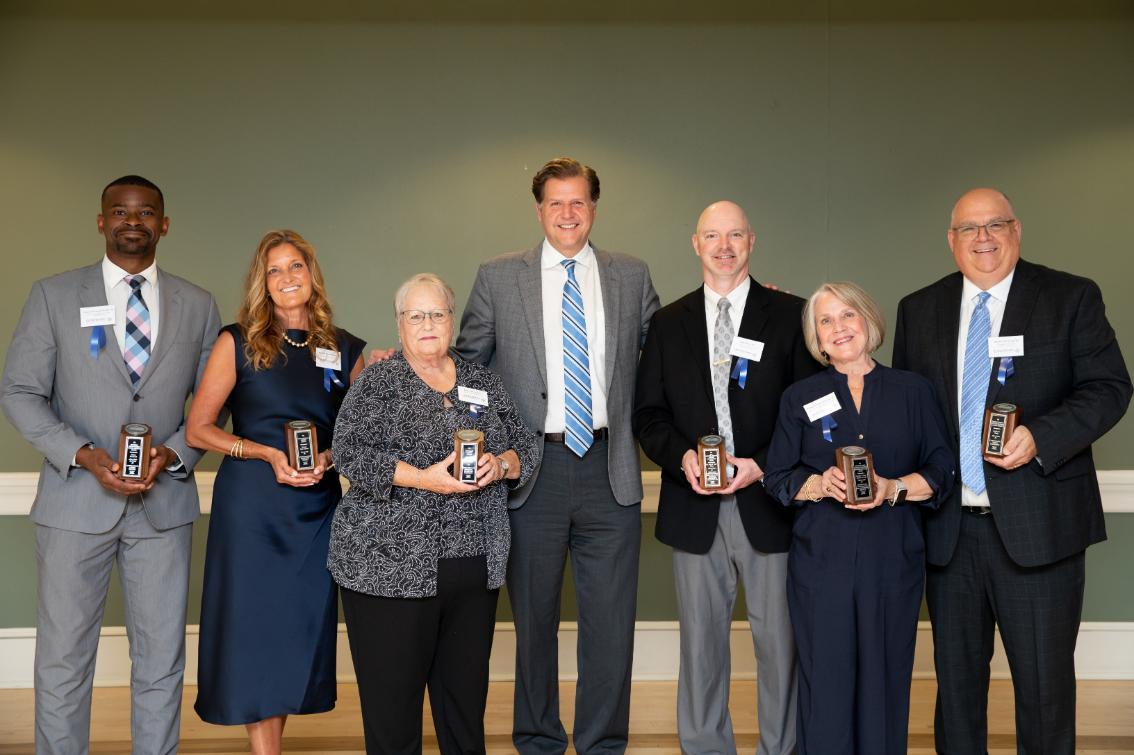
Inspiration. Service. Community. Achievement. These are not just words— they are the powerful and enduring themes woven through the life stories of the 2025 Longwood Alumni Award recipients. The awards annually honor Longwood graduates and friends of the university who have gone above and beyond in their professional fields, have generously given their time and talents to uplift others and have remained steadfast in their commitment to the Longwood community.
Selected by the Alumni Board, this year’s honorees stand as shining examples of what it means to lead with purpose and passion. Above all, they represent the best of Longwood: citizen leaders whose loyalty, vision and integrity continue to inspire generations of Lancers to dream big, give back and make a lasting impact.
Ideals of citizen leadership he learned as a student follow alumnus throughout his life
Bradley H. Pomp ’92
Distinguished Citizen Leader Alumni Award
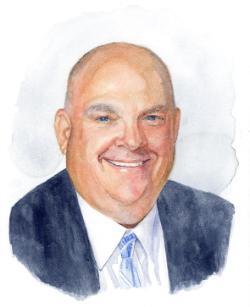
In 1992, seven students came together to found Princeps, an honorary organization to promote leadership in Longwood students by holding up the ideals of citizen leadership as a model for a well-rounded life.
Bradley H. Pomp ’92 was one of those founding members, and the organization’s motto, “To Lead is to Serve,” is an adage he has carried with him throughout his personal and professional path.
“It is a piece of my ongoing walk in life—giving back to the people I’m working with and leading and serving them,” Pomp said. “Citizen leadership to me is truly ‘to lead is to serve’ and to serve the people that you are hoping to bring along and have them do great things.”
Pomp is the 2025 recipient of the Distinguished Citizen Leader Alumni Award, which recognizes alumni who have achieved outstanding success and national distinction in both their personal and professional lives, making them the embodiment of a citizen leader.
Being a leader didn’t interest Pomp much during his adolescence. But his formative experiences at Longwood changed that and laid the foundation for a life defined by leadership and service.
“Longwood was the perfect environment to step out of my comfort zone and try things that I had never done in high school,” Pomp said. “I’d never been involved. I’d never challenged myself to take on leadership roles and be in the front of the room. Longwood allowed that to happen. It was a great place to grow that leadership walk and build that foundation so long as I wanted to continue down that path.”
That walk eventually led Pomp to be elected Student Government Association president at Longwood, serve on the Honor Board and lead his fraternity, Pi Kappa Phi, in addition to founding Princeps.
After graduating from Longwood in 1993 with a degree in political science with a pre-law focus, Pomp went on to earn an MBA in finance at George Washington University in 1996, while working a full-time day job. After that he went on to finance roles at several Fortune 500 companies.
In 2002, he founded Defense Litigation Group, which served major clients such as Ford, Michelin and British Petroleum. In 2015, Pomp took on an executive leadership role at Florida-based Sentry Management, and two years later he became president. Under his leadership, the family-owned community association management company has grown from 13 to 25 states and revenues have surged. The company now manages 3,500 communities nationwide.
“Brad Pomp is the very definition of a citizen leader—in business, in service and in life,” said Athletics Director Tim Hall. “He cultivates a workplace culture that doesn’t just prioritize success, it prioritizes people. Brad remains grounded in what matters most. He is a generous friend, devoted husband and proud father.”
Pomp met his wife, Shannon Nunnally Pomp ’93, at Longwood, and they have remained dedicated supporters of their alma mater. They endowed the Pomp Family Citizen Leader scholarship to support student leadership in campus organizations and made significant contributions to renovating the student athlete weight room in Iler Hall, which is now named the Pomp Sports Performance Center.
The Pomps have also been champions of the Cormier Honors College annual leadership retreat.
“This program is designed to help new scholars build early connections, foster a sense of belonging and develop the confidence and community that lead to greater academic success and campus involvement,” said Dr. Chris Kukk, the Wilma Register Sharp and Marc Boyd Sharp Dean of the Honors College. “In other words, the very qualities that Brad brought to Longwood as a student.”
Pomp said that supporting the retreat was appealing because he sees it gives Longwood students many of the same experiences that were foundational for him 30 years ago.
“The honors college retreat is a great example of where students get connected to Longwood immediately,” he said. “They are able to start to step out of their comfort zone and be in an environment that lets them challenge themselves and take on new opportunities.”
Pomp, who gives back to his home community through volunteering as a youth coach and as a leader in his church, said he was deeply honored to receive an alumni award. But he added that it is somewhat ironic because he often feels like it should be the other way around—he should be recognizing Longwood for everything it did for him.
“Longwood did a tremendous amount for me in my life in terms of getting me the right foundation and getting me turned in the right direction,” he said. “The path that this university put me on professionally and personally was very impactful. More than anything it is nice to know that somewhere I made Longwood proud after all that it did for Shannon and me.”
Historic preservation is all about the present for alumna known for her leadership of Preservation Virginia
Elizabeth Stanton Kostelny ’81
Distinguished Professional Achievement Alumni Award
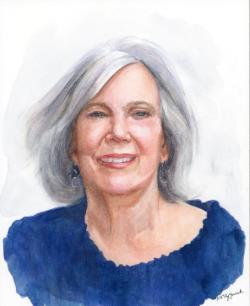
One sunny day in 1967, an 8-year-old girl stood with her grandmother on the bank of the James River and looked out over the area that America’s first British colonists named Jamestown. Missing from the view was James Fort—believed to have been lost due to erosion from the river—the first structures built after the settlers arrived and encompassing a storehouse, a church and a number of houses. The grandmother, who loved history, talked with her young granddaughter about 1607 and the arrival of Capt. John Smith, remarking wistfully, “Imagine what we could learn if the original Jamestowne settlement hadn’t been lost.”
Elizabeth Stanton Kostelny ’81 vividly remembers that day with her grandmother and how oddly prescient it was.
Nearly 25 years later, in 1990, she would join the staff at Preservation Virginia. There she joined the team that planned, secured funding and supervised a massive project at Historic Jamestowne that included the excavation of James Fort, which archaeologists had just discovered was actually on dry land and hadn’t been lost to erosion after all.
“It would be a surprise to my grandmother that her granddaughter got to be a part of that,” said Kostelny, an art education major at Longwood, who went on to become CEO of Preservation Virginia in 2001 and held that position until her retirement in 2024. Her grandmother also would no doubt be proud that her granddaughter had a hand in everything that has been and continues to be learned from the excavation and other projects on the 22 acres of Jamestown owned by Preservation Virginia—and of her selection as the recipient of Longwood’s 2025 Distinguished Professional Achievement Alumni Award.
Since the fort excavation began in 1994, more than 3.5 million artifacts have been recovered from the site, said Kostelny, and “it continues to reveal insights into the interactions between Virginia’s indigenous people, English settlers and Africans who came to this continent in the early 17th century.”
The Jamestown Rediscovery project put Preservation Virginia in the spotlight, but as the oldest state preservation organization in the country, Preservation Virginia has impacted many additional historic sites, both directly and indirectly.
“When I became CEO, the organization was in transition and needed to be restructured and reimagined so that it was financially sustainable and relevant,” said Kostelny. “That apparently was a talent I didn’t know I had: How to work with organizations and how to transform them. While I was there, we went from owning 28 historic sites to owning seven, six of which are open to the public. We transferred the other properties to organizations that could care for them more completely. And we changed our approach to provide communities with the skill sets and contacts and tools they needed to preserve the historic sites in their communities.”
Kostelny gave several examples of Preservation Virginia’s influence in helping communities save their important historic sites during her time as CEO:
- Several of the Rosenwald schools, which were established to educate Black children during segregation, including a school in Cumberland County that is fighting a landfill project and raised funds to preserve the school and repurpose it as a community center.
- Shockoe Bottom, the second-largest trading place for enslaved people, which had been selected as the site for a baseball stadium and instead has become a memorial park and educational area.
- Rassawek, the historical home of the Monacan nation, which successfully thwarted plans to locate a water-treatment plant there.
Among the properties Preservation Virginia continues to own and operate are the home of John Marshall, fourth justice of the U.S. Supreme Court who was influential defining the role of the court; a house in Surry County that recent research revealed had been purchased by three freed African farmers in 1886, adding to the story that will be used to educate visitors on events after the Civil War, especially those affecting African American farmers in that region; and Bacon’s Castle, the oldest brick dwelling in North America, built in 1665 in Surry County.
“For Bacon’s Castle we acquired funds to replace the roof and repoint the distinctive brickwork. Things like that are not the sexy part of historic preservation, but these old places have to be cared for and these are the big-ticket items,” she said.
Kostelny discovered her passion for historic preservation in a roundabout way, falling in love with museum work during her graduate studies in art history at the University of South Carolina and then, after a move to Richmond, taking the position at Preservation Virginia when she was looking for a museum job.
“Some people can view history as being very stagnant—that it’s dates and events about the past. But I think when you stand in a building where important, or even mundane things, have happened over the centuries or you stand at an archaeological site last touched by someone 400 years ago, something awakens inside of you and you see that history is very much present,” she said. “These sites are important not only because of what happened there but also how what happened there has influenced things today. In that way, the history contained in historic sites is really dynamic.”
Alumna creates an oceanside place of respite and healing for women fighting cancer
Michele Sims-Gannon ’90
Humanitarian Alumni Award
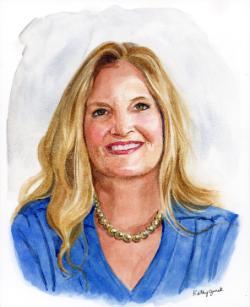
In January of 2009, Michele Sims-Gannon ’90 was in bed with the flu—but she wasn’t alone.
Piled up around here were her three children—then 2, 4, and 6—all of them staring at her and wanting to know: When are you going to get up from there and take care of us?
“It made me wonder what a woman does when she has a long-term illness like cancer,” Sims-Gannon said. “Who is giving her permission to hit the pause button on her responsibilities even for a few days?”
Shortly thereafter, she had a dream about the Virgin Mary that seemed connected. “She came to me as a very strong, empathetic, loving woman,” said Sims-Gannon, a strongly spiritual person who lives near the coastal town of Ocean Grove, New Jersey. “In the dream, she walked me along the ocean, and, with every step, placed in my heart that I needed to act—to do something.”
Not one to waste time, by the end of June that same year, Sims-Gannon had filed the papers to create a nonprofit organization that would provide a safe, healing space for women fighting cancer; rented two rooms in a friend’s bed and breakfast in Ocean Grove; and opened the doors to Mary’s Place by the Sea.
Just 16 years later, Mary’s Place welcomes more than 1,000 women a year at a 10,000-square-foot custom-built facility just a block from the ocean. It is an accomplishment that makes Sims-Gannon more than worthy of being named the recipient of Longwood’s 2025 Humanitarian Alumni Award.
Mary’s Place offers three retreats each week: one Tuesday through Thursday morning, a one-day session on Thursday, and finally a weekend retreat that begins Friday morning and ends Sunday morning. Another 5,000 women are served through virtual programming.
In addition to the on-site accommodations and healthy meals for breakfast and lunch, Mary’s Place provides services including oncology massage, reflexology, Reiki, guided meditation, individual and group counseling, and group activities including art therapy, yoga, prayer, expressive writing and soul collage/vision boarding.
Sims-Gannon knew from the outset that she wanted the services and accommodations provided by Mary’s Place to be free of charge. “In 16 years, we haven’t had to charge a woman a single dollar to come here,” Sims-Gannon said. “This is life-changing for so many women.”
Currently, Mary’s Place raises $1.4 million annually to support its mission. Stretching those funds as far as they will go are 60 practitioners, many of whom donate their services, and 100 volunteers who supplement the organization’s seven full-time staff members.
From the beginning, Mary’s Place has depended on the kindness of friends and strangers who believe in its mission. When the organization outgrew that initial bed and breakfast and soon thereafter a rented five-bedroom home, Sims-Gannon and her board appealed to a local bank to lend them enough money to purchase land and construct their current facility.
The two lots a block from the water in Ocean Grove alone cost $700,000, she said. “There is no way we could have personally financed it. They believed in us. They felt our passion.” So did her husband, a local builder who submitted the low bid for the construction, and a bevy of subcontractors, who donated time and materials. The first guests arrived in June 2016.
“We built our 10,000-square-foot home in 18 months,” said Sims-Gannon, adding that the expansive porches with ocean views are one of her favorite features. “I love seeing the women in the rocking chairs on the porches, some of them wrapped up in blankets even in the winter, just looking at the ocean. So many women come here from land-locked areas, and the ocean is very healing to them.”
Mary’s Place supports women with any type of cancer at any stage. They learn about Mary’s Place from a variety of sources, including cancer support groups, and travel to the Jersey Shore from all over the United States—primarily New Jersey, Pennsylvania and New York, but also from California, Arizona, Alaska, Hawaii and beyond—as well as Canada and Europe. The average age of guests is 47. “These are working women in childbearing years with children at home,” said Sims-Gannon. “We’re now seeing a huge shift toward younger women.”
It seems impressive that someone could build such a large and complex organization from nothing, but Sims-Gannon, who earned a degree in German at Longwood, says it’s just part of her personality, which first showed itself when she transferred to Longwood from Arizona State.
“I just didn’t feel a connection at Arizona State. I felt overwhelmed at the size of it,” she said. “I had a friend at Longwood who was also was studying German. She said it was a great department, and the teachers all know you. I was just 18 years old, but I didn’t hesitate. I packed up my car and drove across the country to get to Farmville.
“Coming to Longwood was really what laid the groundwork for me to stretch myself to the unknown. You don’t have to know everything that’s going to happen. You just have to be open and adaptable,” Sims-Gannon said. “There’s no stopping me once I get set on something.”
And she’s not stopping with just one Mary’s Place. Due to the overwhelming demand and the lengthy waitlist, Sims-Gannon said the organization’s expansion committee is currently looking at a second location with hopes of building a second facility within the next three years.
“We now get more than 2,000 applications a year for our retreats,” she said. “It is validation that we have created something that fills a need. The gratitude from the women who come here is what fuels every person to do what we do. When you have a woman say to you, ‘Thank you. This is where my healing began,’ that’s motivation to improve it and to grow it, so you can reach more women.”
From roller-skating on the Colonnades to a 42-year career, her connection with Longwood spans a lifetime
Karen Schinabeck
Honorary Alumni Award

Karen Schinabeck may not have graduated from Longwood but she’s had a longer relationship with the university than many people who did.
With her childhood home on Buffalo Street just a stone’s throw from campus, she remembers summers spent with friends roller-skating up and down the Colonnades, sneaking through the tunnels trying to scare each other and riding their bikes around campus. “I pretty much grew up at Longwood,” she said.
After graduating from high school and then business college, she came back to Longwood for a 42-year career, with 38 of those years in the financial aid office. Advancing from financial aid counselor up to director, she connected with generations of students—many of whom stay in touch with her to this day.
So it seems entirely fitting that Longwood chose to honor Schinabeck with its 2025 Honorary Alumni Award.
During her years as assistant, associate and finally director of financial aid, she says, “Hands down my favorite part of the job was counseling families. I loved talking to students and parents—getting to know their situations and helping them make a plan for how they would finance their education.
“I have so many special relationships with former students. One group who were at Longwood in the 1990s stands out,” she said, adding that most of them relied heavily on financial aid as students and that they all have stayed in touch with each other and with her. “Now all of those students are so successful. They’ve stayed friends, and they have an appreciation for their Longwood education.”
All that said, she is proud of her contributions as a leader of the financial aid office—including five stints as acting director—most notably steering the office through the roiling and rocky waters of implementing the financial aid module of the university’s new (at that time), computer-based student information system known simply as Banner.
“It was my greatest accomplishment as well as my greatest challenge,” she said. “One reason was that I was the acting director then because the director was on medical leave. The Banner implementation dropped right into my lap.”
It was not a task for the faint of heart. In fact, Longwood’s registrar at the time quit her job rather than deal with the transition, Schinabeck recalled. But Schinabeck herself was not the kind of leader who gave up easily—or at all.
“Many times the financial aid staff—including me—became really frustrated. I reminded them that since we had to do this, let’s just do it, and be proud of it. They hung in there. I had a staff and a half. I was proud that financial aid succeeded with implementing their Banner module—and no one quit!”
These days Schinabeck keeps her Longwood connection vibrant by helping out on campus from time to time on a temporary basis and cheering on Longwood’s basketball teams from Seat 8, Row C, Section 111 in the Joan Perry Brock Center.
About her Alumni Award, she says, “Simply put, I am proud and honored to be an honorary alum at the university I love and that has played such a pivotal role in my life.”
Alumnus with Prince Edward roots unleashes his ambition on big dreams for Moton Museum
Cainan Townsend ’15, M.S. ’20
Young Alumni Award
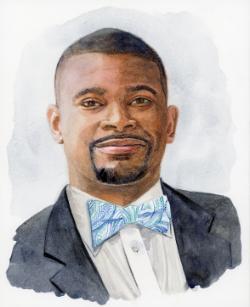
Cainan Townsend ’15, M.S. ’20, is a teacher—just as he decided he would be when he was a sophomore in high school. But don’t look for him in a traditional classroom teaching math or spelling, as noble as that work is.
His classroom is the Moton Museum, housed in the former Moton High School building in Farmville and the only museum in Virginia dedicated to the fight for civil rights. His subject area is Prince Edward County’s critical role in that chapter of American history. And he strongly believes in educating people—not just those in Virginia—about the events in Prince Edward County that helped change the construct of American society.
Townsend’s nine years of work helping to build up the museum—including the last two as executive director—combined with his contributions in the Farmville/Prince Edward community and at the state level secured his place as the recipient of Longwood’s 2025 Young Alumni Award.
He is in his second term as an elected member of the Prince Edward County School Board and counts as one of the board’s biggest achievements the hiring earlier this year of fellow Longwood alumnus Chip Jones ’07, M.S. ’04, as superintendent. Townsend has also contributed to several statewide initiatives, including as a member of the African American Cultural Resources Task Force and the Virginia Commission on African American History Education.
As a native and lifelong resident of Farmville—and a product of the Prince Edward County public schools—Townsend is passionate about his community, including its past, present and future. That passion grows not only out of Townsend’s own experiences but also his family history, which is closely interwoven with that of the county.
His father was among the students locked out of the Prince Edward County Schools when they closed from 1959-64 to avoid integration. He was only 6 years old at the time, and the closings delayed his high-school graduation until he was 21. In addition, Townsend’s great-grandfather and two of his great-aunts were plaintiffs in the Prince Edward lawsuit that was rolled into the landmark civil rights case Brown v. Board of Education.
But there is also the time the Farmville community rallied around Townsend’s family when their home was destroyed by fire. Townsend was only in the first grade when that happened, but it is a vivid and powerful memory, as are the many educational opportunities he took advantage of in his K-12 years in the Prince Edward County schools. Then there are his years at Longwood—which he describes as “like being on a different planet” even though he never left Farmville—and his experiences with the Moton Museum.
All that said, know this: Do not disrespect Farmville or Prince Edward County when Townsend is within earshot.
“I developed a sense of pride for this community partially because of those things but also partially because I didn’t appreciate the way Prince Edward was talked about. We have a community here with a rich history, and it’s worth fighting for,” he said.
It’s natural to wonder why someone with Townsend’s ambition and abilities has not been led to opportunities on a larger stage. But Townsend will tell you that, so far, he’s found everything he was hoping for right where he’s always been.
“There was a spell when my dream was to be Virginia’s secretary of education, and everything I was trying to do professionally was moving toward Richmond. But the more I was telling the Prince Edward story and being genuine and authentic, the more the opportunities came my way. Every time I reached a crossroads or had a doubt, all roads led me back to Farmville. I was appointed to boards. I got introduced to governors. During the Vice Presidential Debate, I had the opportunity to take Sen. Tim Kaine and then-Secretary of Education Anne Holton on a tour of campus. If I can be a conduit to people hearing about our history and if my enthusiasm is infectious, opportunities will come. I don’t have to live in Richmond,” he said.
Townsend is not dismissing the possibility of life leading him elsewhere, but for now he’s focused on the big dreams he has for the Moton Museum.
“We are currently nominated for inclusion on the UNESCO World Heritage List, which is the highest historical designation you can achieve internationally. We should be in place to be considered when UNESCO convenes in 2027,” said Townsend. The list currently includes 1,248 cultural and natural heritage properties around the world that the World Heritage Committee considers as having outstanding universal value. In the U.S., that includes Independence Hall and Monticello. “It will bring a level of status that will significantly elevate the museum and strengthen our ability to secure grants to fund more programs and staffing,” he added.
His ultimate dream is a feature film or TV miniseries about the civil rights movement in Prince Edward County.
“I call it the Hidden Figures treatment,” he said, referring to the feature film about the Black women who made history working at NASA during the space race of the 1960s. “I want 20,000-30,000 people to be visiting here each year instead of 10,000-13,000. I want the Moton Museum to be a place where, if you are a scholar and you want to tell about the civil rights movement, at some point you need to come to Farmville. I’d like to build a research center somewhere in town that’s part archive and part research center.”
If you ask Townsend where his belief in the ability to achieve such big dreams came from, he’ll tell you that his Longwood experiences were key.
“I was national chapter president of the year for Phi Mu Delta fraternity. I was one of the first Elwood mascots. I was in Mortar Board [an honor society for upcoming leaders], and a participant in Call Me MISTER [a program for young men aspiring to be teachers.]
“Longwood taught me people skills. It taught me to advocate for something I’m passionate about. It taught me conflict resolution and to learn from others and to challenge myself. Longwood was a big part of the laboratory that taught me to leave my comfort zone. It’s the reason I am who I am today.”
From student leader to staff member to donor, her relationship with Longwood has been a ‘wonderful journey’
Candice “Candy” Jamison Dowdy ’69
Page Cook Axson McGaughy Lifetime Loyalty Award
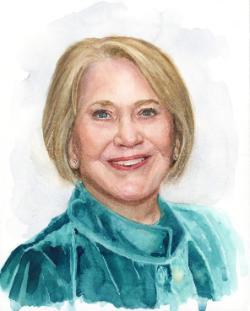
Candice “Candy” Jamison Dowdy ’69 arrived in Farmville as a college freshman in the fall of 1965, and she’s been here ever since.
During her years as a student and campus leader she fell in love with Longwood and, her junior year, met the love of her life—her husband of 56 years, Charles “Chuck” H. Dowdy III, a Farmville native.
“He was a local guy and everyone told me don’t date a local because you might end up staying here,” the Roanoke native recalled with a laugh. “And God knows, that’s what happened.”
After graduating with a degree in home economics in 1969, Dowdy began her professional career working as a home economist at Southside Electric Cooperative in Crewe. She said she thought she might travel the world working for a larger international company, but she was thrilled to find a job nearby in her major.
However, her love for her alma mater pulled her back to Longwood a few years later, and she began working in the Admissions Office. Later she would also work in the university’s Advancement Office. But a large part of her career was spent at nearby Hampden-Sydney College, where she worked for over 20 years before retiring as director of constituent relations. All the while, she continued to volunteer at events and offer her time to her alma mater whenever needed.
In honoring Dowdy, Assistant Vice President of University Priorities Trey Eggleston noted that her leadership abilities became evident not long after arriving at Longwood, when she was elected freshmen class vice president.
“She quickly became a leader among her peers,” Eggleston said. “Serving as president of the legislative board, orientation leader, a member of home economics honor society Kappa Omicron Phi, and she was ultimately tapped into Geist, now known as Mortar Board.”
She eventually was elected student government president, a position which led to a long friendship with the late Dr. Henry I. Willett Jr., Longwood’s 20th president. She was the student representative at Willett’s inauguration.
“He asked for my opinion on so many things,” she said of Willett, who was widely admired for his pivotal leadership during his tenure from 1967 to 1981. “We were great friends as adults. He was kind and generous, and a very good president.”
Dowdy has served on the Longwood Foundation Board of Directors and the board governing the Longwood Center for the Visual Arts (LCVA). The Dowdys have also been generous supporters of the LCVA Gala and Longwood’s basketball programs. Among the many hats she has worn over the years, one of her most treasured roles has been serving as an adviser to her sorority, Alpha Sigma Alpha.
“In truth, Candy has not just been involved, she engages. She shows up, she cares. She knows the students and they know her,” Eggleston said. “She’ll be the first to ask about your time at Longwood and where life is taking you next. And probably the last to leave a conversation because she truly listens.”
Dowdy said she was surprised, thrilled and grateful beyond words when she learned she was the 2025 recipient of the Page Cook Axson McGaughy Lifetime Loyalty Award, which is awarded to honor alumni volunteer service to the university through active participation in alumni or university affairs, faithful and continued support in expanding the influence and prestige of Longwood and a history of philanthropic giving.
“I feel like I owe Longwood so very much,” she said. “The people I met along the way at Longwood prepared me for so many next steps. I was grateful for all of those opportunities. It really helped make me who I became.”
Dowdy said one thing that makes the university so special is the people, especially those that she got to work and interact with during her years on campus. The feeling is certainly mutual.
“She leaves a mark on everything she touches, whether it’s a program, a person or a place,” said Men’s Basketball Head Coach Ronnie Thomas. “To me, and to so many of us, that is the very definition of lifetime loyalty.”
Dowdy added that her children laugh because she continues to tell the same cherished stories over and over about her experiences at Longwood.
“It’s been a wonderful journey, and I wouldn’t have had it any other way,” she said.
From serious conversations to silly costumes and dancing, professor is laser-focused on engaging with students
Dr. Jake Milne ’99
Nancy B. Shelton Spirited Contributor Award
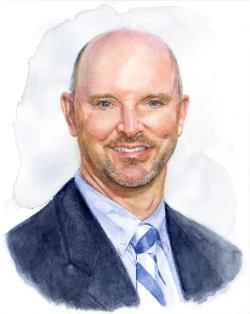
If you tallied up all the extra miles Dr. Jake Milne ’99 has gone for his Longwood students, they would probably circle the moon. But what’s even more impressive is how he’s traveled those miles.
As you might expect, he puts in way over the required number of office hours and helps struggling students overcome challenges. But he also has refereed countless games of Oozeball (volleyball played in a mud pit) during Spring Weekend; advises student organizations including The Big Event, a day of community volunteering, and Longwood Ambassadors, who give tours; and leads a study abroad course to England and Scotland every other year. For 10 years—joined by his best friend and fellow professor Jeff Halliday—he danced the night away at Late Night Breakfast in elaborate costumes as Elvis, Superman, half of the Dumb and Dumber duo and many others.
That’s just a short list of the ways Milne energetically, enthusiastically, joyfully and humbly embraces his role as a Longwood faculty member. The word “spirited” doesn’t begin to do him justice, but he is extremely honored to be the recipient of the 2025 Nancy B. Shelton Spirited Contributor Award, which recognizes the contributions of an alum who is a current or retired Longwood faculty or staff member.
Milne joined the sociology faculty at Longwood in 2006 after completing his Ph.D. at Virginia Tech. He has been an impactful campus presence ever since.
“When someone is needed to give a perspective or a new faculty member a tour of campus, take a wild guess who they call first,” Halliday said in his video introduction of Milne at the awards presentation in June. “When students or our student-athletes are asked to recognize a faculty member who has made a positive impact on their life, guess who makes the list every time. When alumni come back to see their old stomping grounds, guess who they run up to greet?”
Milne’s intense campus involvement as a faculty member at Longwood is an extension of his undergraduate student days, when he was a Longwood Ambassador, a founding member of a student educators organization, a peer mentor and a member of Phi Kappa Tau Fraternity. During his first class with retired sociology professor Dr. Ken Perkins, he “fell in love” with the subject and switched majors from therapeutic recreation. By sophomore year, he knew he wanted to teach; by junior year, he knew he wanted to do that as a college professor.
“Being a professor is more than standing in front of a classroom,” he said. “It’s helping students navigate this world. Students come to my office and tell me why they’re struggling. We just sit and talk. I’ve always known that I wanted to make teaching my primary focus. Part of the reason I became a professor was that that I wanted to be engaged with my students.”
Nowhere was that manifested more colorfully than in Milne’s involvement with Late Night Breakfast, an event that happens toward the close of each semester to give students a break from studying. Faculty and staff volunteer to serve breakfast, there’s a DJ playing music and there’s dancing. It was the perfect venue for Milne and Halliday to show their silly side and relate to students on a personal level.
“It started out with our being there to simply clean off tables and walk around and chat. When the music came on, we started doing the dances with the students,” Milne said.
And then came the costumes.
“We always had a theme. One of my favorites was when we did Dumb and Dumber. I wore the Carolina blue tuxedo, and Jeff wore the orange tuxedo. We did the Blues Brothers. We dressed up as Buzz and Woody from Toy Story. Honestly, we did it for the fun of making a fool of yourself and letting students see you do it.”
That’s not to say that Milne doesn’t enjoy the serious side of academia. He has done research on hearing loss (he has congenital hearing loss and wears hearing aids) and on soccer referees, inspired by his 25 years as a youth and adult amateur soccer referee.
“I loved being a referee,” he said, unable to resist adding a characteristically humorous side note. “I am convinced my hearing loss made me a great referee because I didn’t have to listen to anyone yelling at me.”
Also characteristically, Milne turned the spotlight away from himself toward the end of this interview to focus on others. “There are so many people who do a fabulous job at Longwood, and they don’t get a lot of recognition. Shout out to those folks who make my job easier and make it fun to be at Longwood—students, faculty and staff. That’s what is important to me—that everyone on campus knows they are appreciated.”
